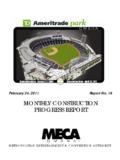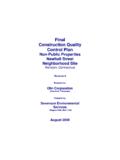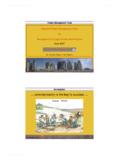Transcription of Background: Why Monthly Reports?
1 The following instructions are designed help you to use The Advancement Foundation Monthly Reporting Template and In-Kind Reporting Spreadsheet which have been sent to you separately in an Excel format. You will enter all actual data and information into those documents. Please take a look at their set-up before reading the instructions provided here. Good luck! Background: Why Monthly Reports? The Corporation for National and Community Service requires that all AmeriCorps*VISTA sponsoring organizations complete Project Progress Reports. Corporation personnel use the reports to track project accomplishments, challenges, resources generated, project sustainability, and support provided to AmeriCorps*VISTA members. The Monthly reports are also an important resource for TAF as it seeks to stay informed about the work going on at each VISTA site and to better support and publicize this work. The TAF Monthly report is like any other grant report .
2 If your organization wants to continue to receive support from AmeriCorps*VISTA and TAF, your report has to be complete and on time! The purpose of the Monthly report is to: Document progress toward achieving project goals and objectives; Provide a self-assessment tool to VISTA projects to promote continuous improvement; Identify technical assistance needs (from AmeriCorps*VISTA as well as TAF); Help TAF to track and better support the work ongoing at its sites; and Collect information for distribution to the public (all information reported in a Monthly report is public information!) Important: How to Submit Your report All Monthly Reports should arrive in the VISTA Leaders e-mailbox by no later than 5pm EST on the Monthly report deadline. All Quarterly Reviews should be scanned in or faxed to the VISTA Leader. If you have extenuating circumstances that lead you to require an extension on your Monthly report , please contact the VISTA Leader at least three days in advance of the deadline.
3 Please e-mail the following complete documents to your VISTA Leader: 1. Completed Monthly Reporting Template (Excel) (Includes: Narrative and In-Kind reporting) 2. Any attachments in relation to the Monthly report - press releases, mailer, flyer, etc. 3. Any photos that are relevant for that reporting month 4. A time sheet for each month 5. Completed Quarterly Review Signature Page due every quarter (listed on due date document) -Scanned or Faxed on due date- includes VISTA and Supervisor signature The remainder of this document gives you specific instructions on filling out each section of your Monthly report . We hope it helps! If you have any questions, please contact the VISTA Leader. Narrative: Narrative/Partnerships/Sustainability/Tr aining Needs/Stories/Challenges Please respond thoroughly under each of the headings in the Narrative Section of the Monthly Reporting Template leave no section blank.
4 If you have few accomplishments to report under a heading, explain why and describe plans for the future. Ask yourself: how are these efforts are addressing your ultimate goal as a VISTA to build the long-term capacity of the organization of which you serve? How are they keeping long-term project success in view? Delete any example text and replace with your own text. If you have any questions about the Narrative sections, contact the VISTA Leader at 540-345-1292 Quantitative Reporting: Hourly Breakdown and Performance Measures The Hourly Breakdown section is a tool that helps TAF and AmeriCorps VISTA see where a VISTA s time is spent. If a VISTA s time is mostly spent grant writing, for example, we could use that information to possibly connect two VISTAs together to share resources on grant writing. The Performance Measures is a tool to help you record those of your achievements that can be quantified in numbers.
5 It lets you track your progress over time and compare your overall accomplishments to the numerical targets originally set out for your position in the TAF Universal Work Plan. Remember that The Performance Measures Section is NOT a substitute for your VAD the VAD contain qualitative objectives that you should review each quarter with your supervisor and report on in your narrative. Please think about the information requested in The Performance Measures section and consider what your organization will need to do to keep good records supporting the numbers you report . This is a valuable process for any growing organization. You and your sponsor will likely want to develop tools like volunteer logs and in-kind tracking sheets that will serve as important recordkeeping resources for years to come. Here are the basics: To report your numbers (every month): Enter a number (no text please) in every box under the label How Many.
6 If you have nothing to report , enter a zero. Enter your organization under the Organization heading to keep track of how many hours spent and materials developed for which organization. When you are done, save your spreadsheet with your name on the file and send it to your VISTA Leader, and please CC your supervisor. Don t forget: Please be sure not to count resources and materials distributed that have already been counted in any previous month! (ex: grants, cash donations, food donations, press releases, etc.) When in doubt, check past narratives to see what has already been reported. Please be sure to check with VISTAs you are collaborating with so numbers are not counted twice. Ex: If two VISTAs work together to raise $5,000, each reports $2,500 Example of Quantitative Reporting Section: # of 10/TAF10 FAHow # of new active partnerships/coalitions developedDollar value of non-cash resources developed (ex: conference table, food, other items) # of visits made to recruit volunteersDollar value of host site resources developed (should match in-kind total on sheet 2)Performance Measures# of contacts made to Board members# of press releases sent out# of donor contacts made (direct.)
7 Calls, visits)# of volunteers recruited# of grant proposals or sponsor requests submitted# of grant proposals funded this reporting period# of active partnerships continuing from previous reporting period# of informative brochures, flyers, newsletter articles, and other electronic media distributed/createdPlanning & evaluation (event work plans, new/expanded programs)Materials, manuals, and/or checklist developmentWebsite developmentDatabase managementIn field supervision of participants and/or volunteersCollaborations (please describe in narrative)Donor cultivation meetings (attach a call or visit summary)Program development/curriculums, licensing, policies/proceduresOther not included in narrative: Dollar value of cash resources developedMass appeals (calls, newsletters, online contact to donors)Hourly Breakdown (approximate hours)ResearchGrant writing or preparation Please record number of hours spent doing activity Please tell us what organization you are doing a certain activity for.
8 For example: You have spent 30 hours doing Research, please indicate how many hours were for each organization. Please record how many of each item was developed or sent out, as asked. Please record what organization you have developed materials for, contacted, submitted a proposal for, etc. Cash Resources: Actual dollars Non-Cash: Items and volunteer hour(s) values In-kind: Host-site resources In-Kind Reporting: Introduction to In Kind Reporting In Kind is an estimated value of goods and services contributed to a project without charge or fee. (**Remember, money not spent is the same as money brought in, so if you receive a good or service at a reduced rate, you should document the difference between the actual cost and the standard cost). An important part of the value of any community service project, an In Kind report is generally used to estimate in dollars the amount of public and private support received by a given project.
9 Good in-kind reporting has benefits both your project and TAF. AmeriCorps*VISTA will use in-kind data as evidence that the federal funds spent are not only necessary, but that they spark more of support from the community for the project. The sponsoring organization can use this data to calculate match for funding proposals, broadcast their donation-raising success, and keep track of who should be recognized for their contributions. Finally, these reports offer a way to evaluate how effective you have been over time in building a broad base of community partnerships. To the best of your ability please include all relevant contributions in your figures. We request that you make reasonable estimates of as many contributions as possible, no matter how small. If you have questions about what should be counted as in-kind, please contact your VISTA Leader. These count as In-Kind: Value of donated services and/or donated goods (Labor, space, vehicles, training, supplies, equipment) Donated construction services Personalized, individual trainings Consultation time with experts to discuss projects (ex: contractor, accountant, lawyer, etc) Time spent consulting with community leaders about project ideas Reduced cost goods and services (document the difference between the standard cost of the good or service and the actual cost paid) These are NOT In-Kind.
10 Volunteer hours (for purposes of the CNCS AmeriCorps*VISTA grant, do not count as in-kind, but can count as non-cash resources- make sure to document that your non-cash resource is volunteer hours) Anything paid for with your VISTA Cooperative Agreement Anything paid for by AmeriCorps*VISTA or other CNCS programs Any mileage for which your organization reimbursed (only include mileage that is donated ) SAMPLE Portion of a Basic In-Kind report Form Item: Description: Cost: Communication: Copies(B&W): 500 Cost (x .05/copy): $ Copies (Color): 100 Cost (x ): $ Telephone (# of hours): 120 Cost (x$5/hour): $ Faxes (# of faxes): 50 Cost (x .20/fax): $ TOTAL: $ Mailing: Letters (# mailed): 200 Cost ( ): $ Postcards (# mailed): 0 Cost ( ): $ Other/larger mailings: 0 Enter Total Cost: $ TOTAL: $ Services: Supervision hours: *calculated at $37/hour by the ACCWT.



